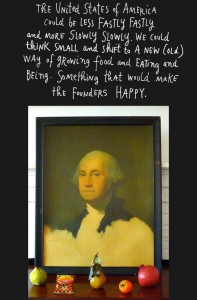Future of Food: the food movement goes mainstream
I’m just back from yesterday’s Future of Food conference in Washington DC. The event, designed by WashingtonPostLive to “advance the conversation” about sustainable food, featured a glittering array of speakers from many aspects of the food movement. (You can watch the conference on video here, and the Washington Post will have a special section on it next Wednesday, May 11.)
The keynote speaker was none other than the Prince of Wales, fresh from his son’s wedding, who gave a serious and inspriring talk that touched on a great range of pressing issues related to agriculture, health, and the state of the world.
Anyone who has been involved in food issues for any length of time had heard these opinions before and most of the speakers were talking to an audience of a few hundred of the converted.
Nevertheless, I think there’s a story here, and not just because I was on one of the panels.
The story is that the event happened. The food movement has gone mainstream.
The conference—sponsored by the Washington Post no less—brought in heavy hitters. These included the Prince of Wales, of course, but also the President of Georgetown University, where the event was held, Eric Schlosser, Wendell Berry, Vandana Shiva, and officials of the FDA and White House.
USDA Secretary Tom Vilsack came, gave thoughtful remarks, and responded with equally thoughtful answers to not-always-friendly comments from the audience. This was the first time I’d seem him in person and I was impressed by how carefully he has thought through the issues he has to deal with. Even when I viewed the issues differently, it seemed clear that his were the result of much intelligent thought and weighing of alternatives.
Montana Senator Jon Tester, of the Tester amendment to the food safety bill, gave closing remarks.
The speakers, young and old, famous and not, made it clear that concerns about the relationship of agriculture to the health of people and the planet were major and were getting focused attention at very high levels.
The food movement can no longer be considered fringe. It’s mainstream. Speakers provided much evidence for that from their own points of view.
They said, it’s now time to take the movement to the next step, and that means doing what it takes to become even more powerful.
For example, see if you can find the remarks of Robert Ross, President of the California Endowment and listen to the opening remarks of his speech about the analogy with tobacco and the need to counter the power of food corporations.
My slightly facetious suggestion: if Congress is for sale, let’s buy our own.
Perhaps you have other ideas for expanding the movement and making it more powerful? Do tell.



